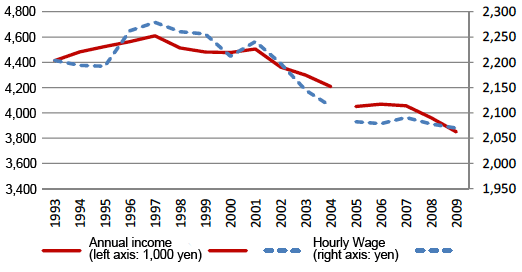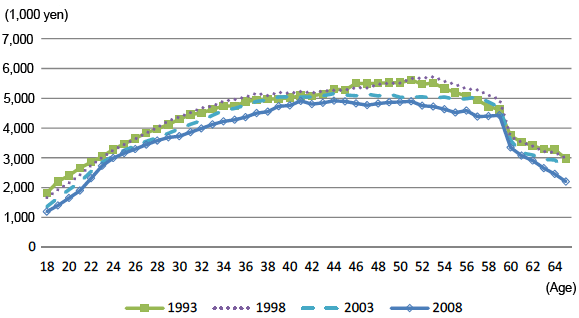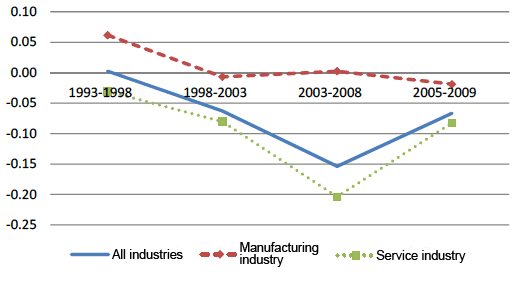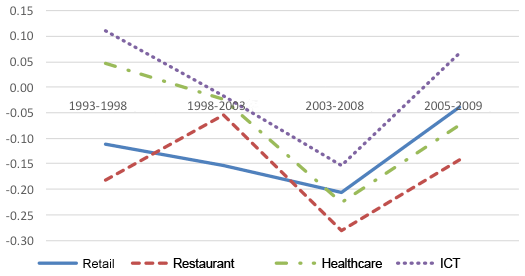In February 2013, Prime Minister Shinzo Abe met with the leaders of the three key business lobbies—the Japan Business Federation (Keidanren), the Japan Association of Corporate Executives (Keizai Doyukai), and the Japan Chamber of Commerce and Industry—at the Prime Minister's Official Residence, and urged businesses to raise wage levels as soon as their earnings recover to help the economy escape from deflation (Nihon Keizai Shimbun, Feb. 12, 2013). How have average wage levels in Japan changed over the years? This column examines whether wage levels are declining, who are affected, and what are the factors behind such wage changes, based on available data.
Are wage levels declining?
Looking at wage changes during the 1990s and 2000s according to the Basic Survey on Wage Structure, wage levels rose gently until 1997, even after the bursting of the bubble economy. After peaking at 4.61 million yen in 1997, the nation's average annual income then fell steadily to 4.21 million yen in 2004 and 3.85 million yen in 2009 (Note 1).

Who are affected?
During these two decades, the aging of the working population accelerated, the service sector captured a larger share of the overall economy, the average number of working hours fell following the introduction of the 40-hour-week rule, and the number of non-regular workers increased sharply. Figure 2 shows the annual income across different ages, measured every five years from 1993. Annual income dropped for all ages from 1993 to 2008, particularly for those in their 30s and 50s. The likely reason for the sharp fall in the incomes of workers in their 30s, but a smaller decline in that of those in their 40s, is that many workers in the 1990s were promoted to managerial positions in their late 30s, but from 2000, such promotions have tended to be for those in their early 40s. In the 1990s, wages rose slightly among those in their late 40s to early 50s, but in 2008, wage levels were flat for those in their early 40s to early 50s.

Figure 3 compares changes in the annual income between the manufacturing and service industry workers, controlling for worker attributes (educational background, age, years of employment, gender, work style (full time/part time), and working hours) for four periods: 1993-1998, 1998-2003, 2003-2008, and 2005-2009. In the service industry, the wage level consistently declined from 1993. The annual income for workers with the same attributes dropped by as much as 8% in 1998-2003 and 2005-2009. On the other hand, the wage level for workers in the manufacturing industry rose by 6% in 1993-1998, dropped by 1% in 1998-2003, leveled off in 2003-2008, and then dropped again by 2% in 2005-2009. Wages dropped more sharply in the service industry than in the manufacturing industry even though the latter faced international price competition.

What are the factors behind wage changes?
Regarding the factors behind the changes in the wages, we notice that the wages of workers with the same attributes in the manufacturing industry rose in 1993-1998, but dropped in 1998-2003. On the other hand, wages fell in the service industry in 1993-1998 due to the increase in the number of part-time workers, in 1998-2003 due to a decline in the average wages of workers with the same attributes, in 2003-2008 due to shorter working hours and an increase in the number of part-time workers, and in 2005-2009 due to shorter working hours (as a result of less overtime and increase in the number of workers working shorter hours) and an increase in the number of part-time workers.
Looking at the details in the service industry, we find that wages in the retail sector declined by 11% in 1993-1998, 15% in 1998-2003, and 4% in 2005-2009 (see Figure 4). The common factors behind these declines were a larger number of part-time workers and shorter working hours. Wages in the restaurant industry fell by 18% in 1993-1998, 6% in 1998-2003, and 14% in 2005-2009. The biggest contributors to these falls were an increase in the number of part-time workers for the 1993-1998 and 2005-2009 periods and a flattening of the wage curve for seniority-based pay systems for 1998-2003. Wages in the healthcare industry, which is considered as a growth industry, rose by 5% in 1993-1998 but then turned downward, falling by 2% in 1998-2003 and 7% in 2005-2009. Wages in that industry rose in 1993-1998 due to rises in hourly wages, but fell in the 1998-2003 and 2005-2009 periods because of a decline in the overall wages. These moves are attributable to major system changes that have taken place since 2000 including the introduction of nursing care insurance and deteriorating finances of healthcare insurance and nursing care insurance systems, which suppressed wage rises. Wages in the information and communications industry are relatively stable: they rose by 11% in 1993-1998, fell by 2% in 1998-2003, but rose again by 7% in 2005-2009. However, the reason behind the rise in 1993-1998 was the rise in the share of aged workers, while the wage increase in 2005-2009 resulted from a decrease in the number of part-time workers. In 1998-2003, overall wage levels for the industry dropped.

Since the 1990s, wages of workers in many industries have dropped due to an increase in the number of part-time workers, shorter working hours, and declining average wage rates. The declines were sharper in the service industry than in the manufacturing industry, and within the former, relatively sharp drops were seen in the sectors targeting consumers, such as the retail and restaurant industries. The manufacturing, information and communications, and wholesale industries, which are exposed to international competition, as well as the service industry targeting corporate clients, experienced relatively small drops in wages. The periods covered by the present analysis coincide with a period in which there were sharp declines in the number of workers in the manufacturing and wholesale industries. This suggests that wages may be on the rise as a result of more skilled workers remaining in the company while the lower-skilled workers have exited. Further analysis taking into consideration the supply and demand of labor is what remains to be tackled.


